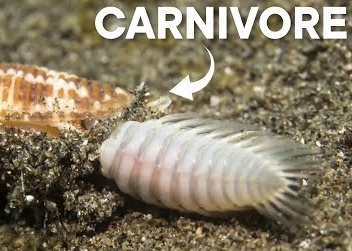10 Unusual Molecules That Will Surprise You
Molecules are fascinating little building blocks of the universe. Think of them as tiny clusters of atoms stuck together, forming the foundation of everything around us. Take water, for example—its simple formula, H2O, hides the fact that it’s one of the most essential molecules for life. It’s the smallest piece of a substance you can isolate without turning it into something completely different.
We’re all familiar with everyday molecules like table salt (Sodium Chloride), the Carbon Dioxide we exhale, or even Ozone that protects us from the sun’s rays. These are the unsung heroes of our daily lives, quietly doing their jobs without much fanfare. But beyond these common players, there’s a whole world of strange, obscure, and downright bizarre molecules out there—some found in nature, others cooked up in labs. These are the kinds of things that make you stop and think, “Wait, that actually exists?”
From molecules that glow in the dark to ones that can mimic the smell of rain, the world of chemistry is full of surprises. Whether it’s a naturally occurring oddity or a human-made marvel, these molecules remind us that science is anything but boring. So, the next time you sprinkle salt on your food or take a deep breath, remember: there’s a whole universe of weird and wonderful molecules waiting to be discovered.
10.Opiorphin is a Powerful Painkiller

You might not know the name Opiorphin, but chances are, it’s already inside you right now. Yes, you read that right—this natural painkiller, which is six times stronger than morphine, is something your body produces on its own. And here’s the kicker: you’ve probably been “using” it without even realizing it. How? It’s found in human saliva. That’s right, your spit might just be hiding one of the most fascinating natural pain-relievers out there.
What makes Opiorphin so special? For starters, it’s not just a powerful painkiller—it’s also non-addictive. Unlike many pain-relief drugs that come with a risk of dependency or tolerance, Opiorphin doesn’t have those downsides. It works by protecting enkephalins, your body’s natural pain-fighting molecules. When you’re in pain, enkephalins usually get broken down, but Opiorphin steps in to keep them active, helping your body manage pain more effectively.
Now, before you get too excited, there’s a catch. Opiorphin breaks down really quickly, which means it’s not yet practical as a standalone painkiller. Scientists are still figuring out how to synthesize it and make it last longer in the body. But the potential is huge. Imagine a future where pain relief is not only effective but also free from the risks of addiction or side effects.
And that’s not all—Opiorphin might also have antidepressant properties. While this is still being studied, the possibility adds another layer of intrigue to this already fascinating molecule. Could our own saliva hold the key to better mental and physical health? It’s a question that researchers are eager to answer.
So, the next time you think about the weird and wonderful things your body can do, remember Opiorphin. It’s a tiny molecule with massive potential, and it’s already working behind the scenes in your body. Who knew something so incredible could be hiding in plain sight—or, more accurately, in your mouth?
9.Penguinone Molecules Look Like Penguins

C10H14O or 3,4,4,5-tetramethylcyclohexa-2,5-dien-1-one is more easily referred to as penguinone. Of course, nothing about the chemical name lends itself to why it’s called penguinone, but there is a reason for it.
If you remember chemistry class, every molecule is bound together in a specific way. For a simple molecule, it may just be two atoms side by side and nothing is interesting there. But the atoms of a molecule of penguinone are bound together in more or less the shape of a penguin, or a stick figure version of one, at least.
The molecule is a ketone, which is why it ends with “one.” Despite the fun name, it has very few applications in the commercial or industrial world.
8.The Sonic Hedgehog Gene is Inhibited by the Molecule Robotnikinin

It may shock you to learn that some scientists are also nerds in their spare time. Because of this, they sometimes will apply geeked-out names to scientific discoveries and procedures. Few things exemplify this better than the Sonic Hedgehog Gene and the molecule known as Robotnikinin.
Let’s start with the gene called SHH. This is a gene in the human body that creates a protein needed for embryonic development. Because of the SHH initials, scientists called in Sonic HedgeHog. So far so good.
Sometime later, researchers discovered a molecule that binds to and inhibits Sonic Hedgehog. There’s a lot of very complex science involved in what Sonic Hedgehog does and why scientists are interested in what molecules may alter how it works, but in very simple terms they were just trying to understand diseases that are related to aberrations in Sonic Hedgehog and embryonic development.
Because Sonic Hedgehog was the established name of the protein already, researchers opted to name the inhibiting molecule Robotnikinin, after Sonic’s rival Dr. Robotnik.
7.Cyclodextrin is a Large Carbohydrate Molecule That Binds to Stink

Cyclodextrin sounds like a poison from some mid-level sci-fi series but it’s a real thing and there’s a good chance you’ve run across it at some point in your life. It’s found in Febreze and it’s what makes the stink-fighting spray do its job.
If you’re savvy to chemical naming conventions you’d notice the “dextrin” in the name, which denotes it’s a kind of polysaccharide. These are usually sticky substances that can be used as adhesives but others, like maltodextrin, are often added to food to improve the texture.
Cyclodextrin, like in Febreze, is a useful molecule thanks to its shape. It takes on a shape like a donut that can trap hydrophobic compounds inside of it. That means it’s able to encapsulate odor molecules after the water in the Febreze partially dissolves them and holds them so they can’t float up to your nose and notice how bad the chair in the basement smells.
6.Orthocarbonic Acid is Called Hitler’s Acid

Acids come in so many varieties that trying to list even half of them could easily put you to sleep. Instead, let’s dive into one especially intriguing specimen: orthocarbonic acid. This isn’t just any acid—it’s a chemical curiosity that exists only in theory, beyond our current laboratory capabilities.
Scientists speculate that the extreme conditions at the heart of Uranus—a gas giant with crushing internal pressures—might be just right for forming and stabilizing this elusive compound. In an environment where ordinary chemistry turns on its head, compounds like orthocarbonic acid could possibly emerge, defying the limitations we face on Earth.
But why should you care about orthocarbonic acid? Well, aside from its mysterious formation, it’s infamously nicknamed “Hitler’s Acid.” This unsettling moniker comes from the idea that if we could create its molecules, they would arrange themselves into a pattern resembling a swastika—a connection that adds a layer of eerie historical intrigue to this hypothetical acid.
This peculiar acid stands out as a prime example of how science can surprise us. It’s a reminder that even in realms where nature and our labs haven’t yet met, the possibilities remain as bizarre as they are fascinating.
5.Old People Smell is Caused by a Molecule Called Nonene

Here’s an indelicate question for you. Have you ever heard of, or encountered, “old people smell”? There aren’t a lot of polite ways to talk about it, but the basic idea is an odor that comes exclusively from older people. If the idea sounds silly to you, you should know that it’s not a made-up thing. As you age, you will start producing a molecule called nonene that has a particular odor. Old people smell is a scientifically verifiable thing.
When you hit age forty, your body starts changing in ways you may not enjoy. Omega-7 unsaturated fatty acids in your skin are going to start to degrade. As they do and are exposed to the oxygen around them, a 2-nonenal molecule is produced. That’s the source of the smell.
For what it’s worth, in studies that identified that old people smell as a real thing, it was also determined that it’s not necessarily a bad odor. In fact, compared to younger people and middle-aged people, the old person odor was not as offensive in some cases. As with any body odor, this probably changes on a case-by-case basis.
In general, the smell of a middle-aged man was considered most unpleasant in the blind tests while old man odor was considered the least intense. Middle-aged women won for smelling the best. Good for you, moms!
4.The Alpha-Gal Molecule Could Make You Fatally Allergic to Red Meat

Alpha-gal doesn’t sound dangerous at all, but there’s some serious risk associated with this molecule and tick bites. The name is the short form of galactose-a-1,3-galactose, a molecule that is already present in most mammals. The danger comes from alpha-gal syndrome, which is an allergic reaction that can be kicked off by a Lone Star tick.
When a tick bites you, their saliva can drop alpha-gal into your bloodstream. These are basically a kind of sugar. Your body reacts to the presence of these molecules by producing antibodies to destroy them because they are foreign Invaders. The problem is that most kinds of mammals also produce the same molecules.
When you eat red meat, the meat is going to have alpha-gal on it. Your body now recognizes these molecules as foreign Invaders and so you’re going to attack those molecules when you ingest them. The result is that you’ve now developed an allergy to red meat.
Like most allergic reactions, there’s a range of severity here. You may only suffer from some itching or hives. However, your throat could also swell up, your blood pressure could drop, and there’s even a possibility that you could die.
3.A Molecule, Abbreviated to “Titin,” is the Longest Word in the World

Have you ever looked up the longest word in the English language before? It’s one of those random trivia things that comes up from time to time and, as you might expect, it’s not a word that you would ever know how to spell or even come close to pronouncing. That’s because it’s over 189,000 letters long. It literally takes three hours to say it, assuming that you can pull such a thing off. It’s also the name of a molecule.
The first several syllables of the molecule are “methionylthreonylthreonylglutaminylarginyl..” which was only included in this script so that someone had to try to pronounce it on camera. For the sake of brevity, most people just call it “titin” or “connectin.”
Why is the name so preposterously long? Because this molecule is a type of protein, and proteins are named after the amino acids that are grouped together to form them. You may remember when you discussed penguinone earlier and its chemical name seemed like a long one at the time. Chemicals are weird like that, which is why we tend to give molecules shorter, fun names for casual reference.
Because it’s a chemical name, not everyone is willing to acknowledge titin as a real word. It’s not like anyone would ever have to say it out loud for some reason, so in some cases, it may not be considered the longest word in the world at all.
2.Cyclopamine Causes Babies to Be Born with One Eye

Hey, remember Sonic Hedgehog? This relates to that! Hedgehog is related to embryonic development, as we said, and there are any number of ways that it can be disrupted or altered as it goes about its business. One thing that can throw a very unexpected monkey in the wrench is a molecule called cyclopamine.
Cyclopamine and its effects were discovered after some sheep in the 1950s were born with just one eye. It was quite a mystery, but it happened more than once, so there was something beyond a fluke going on here. It took 10 years for researchers to discover that the mother sheep had been eating corn lily.
The corn lily contains the molecule that was later named cyclopamine. For reasons that are still not fully understood, cyclopamine interrupts HedgeHog signaling in a way that causes only a single eye to form in the embryo as it develops. It seems to only exist in that one plant and while it doesn’t cause just this one deformity, it’s clearly the most startling one.
1.How Vulcanization Turns Rubber into a Super Material (and It Was Discovered by Accident!)

Rubber, in its natural form, isn’t as versatile as you might think. Sure, it’s stretchy and flexible, but try making a tire out of pure rubber, and you’ll quickly run into problems. When it gets hot, it melts into a sticky mess. When it’s cold, it stiffens up and becomes brittle, like an old rubber band that snaps at the slightest pull. So, how did rubber become the backbone of industries like tire manufacturing? The answer lies in a fascinating process called vulcanization—and its discovery was a complete accident.
Back in 1839, a man named Charles Goodyear was experimenting with rubber, trying to make it more useful. One day, he accidentally cooked a mixture of rubber and sulfur. To his surprise, the result wasn’t a gooey disaster. Instead, he created something revolutionary: vulcanized rubber. This new material didn’t melt under heat or turn brittle in the cold. It was durable, elastic, and perfect for making tires. Goodyear’s accidental discovery didn’t just change his life—it sparked the birth of a tire empire that still dominates the industry today.
But here’s where it gets even cooler. Vulcanization isn’t just about making rubber tougher. It’s a chemical transformation that changes the very structure of rubber. Normally, rubber is made up of countless individual molecules. During vulcanization, sulfur acts like a molecular glue, linking all these molecules together into one giant, interconnected chain. The result? A single, massive molecule. That’s right—a piece of vulcanized rubber, no matter how big, is essentially one molecule. It’s like turning a pile of loose bricks into a solid, unbreakable wall.
This process doesn’t just make rubber stronger; it also gives it unique properties that we rely on every day. From car tires to shoe soles, vulcanized rubber is everywhere. And to think, it all started with a lucky accident in a 19th-century lab. Sometimes, the most incredible discoveries come from the most unexpected places.
























